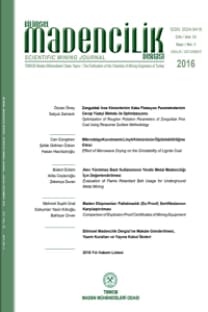Elektromanyetik Afmag Metodu
Yeraltı kaynaklarına olan gereksinim günümüzde en büyük düzeye ulaşmıştır. Dünyada ve
ülkemizde çeşitli yöntemlerle yeraltı kaynakları araştırılmaktadır, AFMAG metodu da bu amaca
yönelik olarak ortaya çıkarılmıştır.
Afmag metodunda alanın manyetik kuzeyle yaptığı açı ve eğim açısı ölçülür. Afmag Ölçü aleti ile
okunan değerler, bir vektörle tanımlanır. Vektörün doğrultusu manyetik kuzeyle yapılan açıyı ve
boyu eğim açısını verir, İki frekansta Ölçü alındığından, iki ayrı manyetik kuzeyden yapûan açı
ve eğim açıları anomali haritaları elde edilir. Anomali haritalanndaki (+) ve (—) kapanışlar birer
doğru üe birleştirüip, bu doğruların birbirini dik yada dike yakın kestikleri noktalar gözlenir.
Bu noktalar iletken kütlenin yerini verir.
1
Eğim açısının uzanım boyunca değişimi incelendiğinde; önce en büyük bir uç değer, daha sonra
sıfır eksenini keserek en küçük uç değeri verdiği görülür. Bu değişimin sıfırı kestiği yer aynı
zamanda iletken kütlenin yeri olarak belirlenebilir
Dependence on the underground natural resources for which the research and exploration
activities are increasingly conducted on by various methods, reached on its ultimate level during
the present era of minerals' development.
AFMAG is one of the above mentioned methods and has been brought out in accordance with this
trend.
AFMAG Method is based on the measurement of the declination angle between the field and the
magnetic north and of dip angle. Values obtained by the AFMAG measurement apparatus are
defined by a vector. Angle between the field and the magnetic north and the dipangle, is given by
the direction and the lenght of this vector, respectively. As the measurement has been made in two
different frequencies, anomalous contour maps of two different magnetic north angles and of dip
angles were obtained.
Closures of (+) and (—) character in the anomolous maps are connected with individual lines and
the intersection of reciprocating lines in their perpendicular and/or quasi-perpendicular positions
are observed. These intersection points indicate the location of conductive underground volume.
When the variation of the dip angle along the extension is sought out, it could be appearant that
the variation yields a maximum value first and then a minimum values intersecting zero axis.
Intersection point of variation and the zero axis could be determined and concluded as the locality
of the conductive volume.
- ISSN: 2564-7024
- Yayın Aralığı: Yılda 4 Sayı
- Yayıncı: TMMOB Maden Mühendisleri Odası
